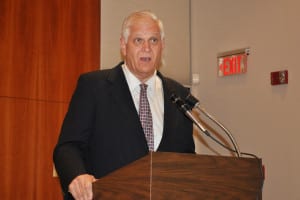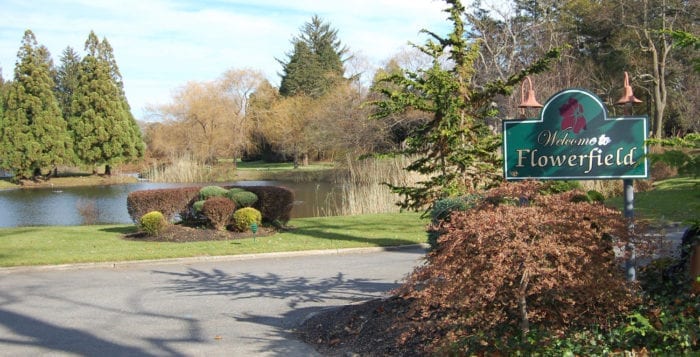Not seeing the forest for the trees is one thing, but a recent decision by Gov. Andrew Cuomo (D) to not preserve the forest or trees for the sake of solar installation is causing a major stir among Suffolk County elected officials.
On Dec. 18, Cuomo vetoed a bill co-sponsored by state Assemblyman Steve Englebright (D-Setauket) and state Sen. Ken LaValle (R-Port Jefferson) that called for the expansion of Long Island’s publicly protected Central Pine Barrens to include more than 1,000 acres in Shoreham and Mastic Woods — “museum quality” stretches of open space that should never be developed by private owners, according to the sponsors. Their legislation aimed to pull the plug on solar plans for the sites.
“The idea of putting solar on these properties is foolish,” Englebright said. “And I hold my solar credentials next to anyone. I am the legislator that sponsored and spearheaded solar more than 20 years ago — these are not good sites for solar.”

A large chunk of the Shoreham property — made up of approximately 820 acres of undeveloped vegetable land, coastal forest, rolling hills, cliffs and various species of wildlife on the shoreline of Long Island Sound — was almost demolished last year under a proposal by the site’s owners, National Grid, and private developers to knock down trees, level ridges and scarify the property to build a solar farm in the footprint. This “replace green with green” plan garnered much community opposition and was ultimately scrapped by Long Island Power Authority, leading civic association and environmental group members to join Englebright in proposing to preserve the parcel by turning it into a state park. The assemblyman also pledged that while there is a great need to install solar panels as a renewable energy source, there are ways to do so without tampering with primeval forest.
In Cuomo’s veto of the proposed bipartisan legislation to preserve these properties, which had been worked on over the past year and passed overwhelmingly through the two houses of the Legislature in June, he said that it “unnecessarily pits land preservation against renewable energy.” The governor voiced his support of developing solar energy projects on the sites and said the legislation as written prevented environmental growth.
“I am committed to making New York State a national leader in clean energy,” Cuomo said in his veto message. “New York’s Clean Energy Standard mandates 50 percent of electricity to come from renewable energy sources like wind and solar by 2030, to be aggressively phased in over the next several years. … Siting renewable energy projects can be challenging. But it would set a poor precedent to invoke laws meant for the preservation of environmentally sensitive land in order to block projects that should be addressed by local communities or through established state siting or environmental review processes. To sign the bill as drafted would be a step in the wrong direction by moving away from a clean energy future instead of leaning into it.”
Among some of the veto’s supporters were the League of Conservation Voters and Citizens Campaign for the Environment. Jerry Rosengarten, the Mastic site’s owner and managing member of the Middle Island Solar Farm, a proposed 67,000-panel green energy development on a 100-acre parcel in Mastic which would cut down woods near the headwaters of the Forge River, voiced his support of Cuomo’s decision in a statement.
“The idea of putting solar on these properties is foolish. And I hold my solar credentials next to anyone.”
— Steve Englebright
“Gov. Cuomo’s bold leadership today is hope that we will be able to effectively fight Trump-era climate denial and the ‘not in my backyard’ shortsightedness that would otherwise prevent crucial environmental progress at the most critical time,” said Rosengarten, an environmentalist who has been working for six years to place a solar farm on the site, making numerous applications to Long Island Power Authority to obtain power purchase agreements. “We look forward to working with the Town of Brookhaven on the next steps toward realizing a solar farm that we can take great pride in together.”
Englebright took issue with the not-in-my-backyard claims, which were also made by the League of Conservation Voters.
“I find that most unfortunate because it’s a falsehood,” he said. “I don’t represent Shoreham. I live in Setauket, and these sites are nowhere near my district. But, on merit, the properties deserve preservation. To have my sponsorship characterized as NIMBY is not only inaccurate, it’s insulting.”
Those who are against the veto have been championing preservation on both sites, including Dick Amper, executive director of the Long Island Pine Barrens Society, and Andrea Spilka, president of Southampton Town Civic Coalition.
“The land is so valuable, environmentally, that it should be preserved,” Amper said of the Shoreham site in the spring when the legislation was first being pushed.
He added that solar is an important renewable energy in combating global warming, but that panels should be installed on roofs and parking lots rather than ecosystems.
“The reality is that once taken, these forest lands will never be recovered,” LaValle said in a statement outlining his disappointment over the veto. “These lands are particularly critical for the ecology of the Forge River. Destroying the forest and the trees to install solar power just does not make sense at either the Mastic Woods or Shoreham Old Growth Coastal Forest properties. … Currently, over 30 percent of New York state’s solar power is generated on Long Island, the majority of which is produced in my senate district. We can continue to expand the green energies where they will benefit Long Island without damaging the environment as we proceed. Destroying the environment is never the direction I wish to take.”

Brookhaven Supervisor Ed Romaine (R), a career advocate for the environment who worked tooth and nail alongside Englebright and LaValle to preserve these sites, said vetoing the bill “was the wrong thing to do.”
“[It’s] the reason why Brookhaven Town adopted a solar code that allows for both the preservation of our open space and the development of solar energy,” Romaine said. “Brookhaven Town was committed to preserving these lands, and worked right up to the hours before this veto was issued to provide the developer with up to 60 acres of alternative, town-owned sites that did not require the removal of a single tree.”
Some of these alternative solar sites, Englebright later explained, were the paved parking lot of the State Office Building in Hauppauge and the nearby H. Lee Dennison Building, each of the Brookhaven Highway Department yards and the roofs of numerous local schools. Englebright successfully pushed for solar panels to be placed on the roof of Comsewogue’s elementary school.
“Regrettably, the developer did not respond to these offers, and the governor did not take these alternative sites into account when issuing the veto.” Romaine said. “I thank the sponsors, Sen. Ken LaValle, Assemblyman Steve Englebright and their colleagues for their hard work to preserve these ecologically important woodlands, and urge them to re-submit legislation for this in the coming session of the state Legislature.”
Englebright said he plans to reintroduce the legislation in the coming weeks.
“We are going to revisit this, and I hope that the governor keeps an open mind going forward,” he said. “It just requires a little bit of thought to realize that we have a vast amount of the Island where you can place solar panels without cutting down forest. By contrast, there are very few opportunities for preservation on the scale of these two properties. This is a source of some frustration.”


















